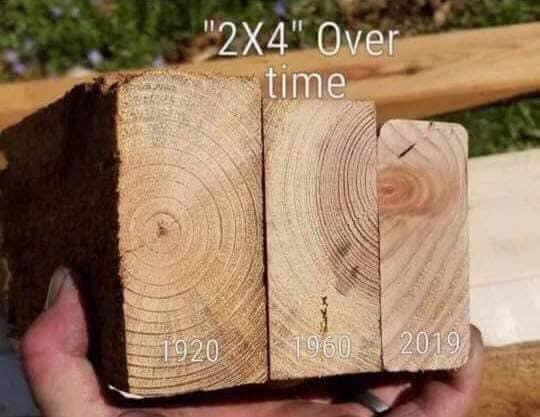If you’ve ever bought a 2×4 from the hardware store and measured it, you’ve probably noticed that it’s not actually 2 inches by 4 inches. This leads many people to ask: Why are 2x4s smaller now? The answer lies in the evolution of lumber standards and how the manufacturing process has changed over time.
In the early days of construction, a 2×4 was cut from raw lumber at a full 2 inches by 4 inches. However, as milling techniques became more advanced, lumber started to be planed, smoothed, and dried to ensure consistency and remove imperfections. During this process, the boards shrink in size, eventually ending up closer to 1.5 inches by 3.5 inches. Despite the reduction in size, the term “2×4” stuck and continues to be used today, even though the dimensions have changed.
This shrinking trend in lumber sizes has made it easier to handle and provides smoother, more uniform boards for building. If you’re dealing with older home projects or renovations, understanding these changes in lumber sizing is crucial for making accurate adjustments. And for those taking on DIY projects that involve wood, check out this expert guide on lacquer and how it impacts your woodworking projects.

Why Is Lumber Getting Smaller?
The ongoing reduction in lumber size stems from a combination of historical practices and the demand for efficiency. As 2x4s and other lumber sizes began to be planed and milled for uniformity, the need for perfectly smooth and straight boards led to dimensional shrinkage. Over time, industry standards adapted to these changes, and the nominal sizes we see today (like the “2×4”) became common, even though the actual dimensions are smaller.
Additionally, as modern construction materials and techniques advanced, builders began prioritizing uniformity and ease of use. Planing lumber reduces the chance of imperfections like knots and rough edges, making the wood more predictable and easier to work with. As such, the smaller, smoother lumber became the norm.
When you’re tackling DIY projects, understanding these lumber size variations is key to ensuring a smooth process. For those looking to upgrade or renovate areas of their home, whether it’s paint or materials, check out this guide on choosing the best paint for kitchen cupboards for expert advice on home improvement.
When Did the 2×4 Size Change?
The shift in the size of 2x4s and other lumber started in the early 20th century. Originally, a 2×4 was indeed 2 inches by 4 inches when cut, but as milling practices became more refined, lumber began to be planed and dried, causing the dimensions to shrink. By the mid-20th century, planing became a standard part of the lumber manufacturing process, reducing the actual size of the boards while improving their consistency.
In 1961, the American Lumber Standards Committee (ALSC) established official dimensional standards for lumber, solidifying the size reduction we know today. A “2×4” now measures 1.5 inches by 3.5 inches. These new standards were meant to create uniformity in construction, allowing builders to work with more predictable and stable materials.
Understanding the history of these changes is essential for anyone working on older homes or DIY projects. If you’re decluttering or renovating, be sure to check out this helpful guide on how to deal with sentimental items when decluttering to make the process smoother.
Why Isn’t Lumber Its Actual Size?
The reason lumber isn’t its “actual” size today comes down to both historical and practical factors. Lumber is initially cut to the full dimensions—such as 2 inches by 4 inches—but during the milling process, the wood is planed and smoothed to remove rough edges, imperfections, and moisture. As a result, the final product shrinks to a smaller size, with a standard 2×4 now measuring 1.5 inches by 3.5 inches.
Despite this dimensional change, the original names like “2×4” remained, mostly due to tradition and familiarity within the construction industry. The nominal size serves as a shorthand for contractors and DIYers, even though the actual measurements are smaller. Understanding this discrepancy is crucial when purchasing materials, as it can affect how much lumber you need for a project.
When you’re managing a home improvement or renovation project, it’s always smart to double-check your measurements and understand the materials you’re working with. For additional tips on handling challenges in home projects, from dealing with odors to selecting the right products, take a look at this guide for bathroom odor removal to simplify your next project.
The Impact of Shrinking Lumber on Modern Construction
The reduction in lumber sizes, particularly the shrinking of 2x4s, has had a lasting impact on modern construction techniques. While today’s smaller lumber may seem like a disadvantage at first, it actually benefits builders by providing more predictable, uniform materials that are easier to work with. Modern 2x4s are also more stable due to the drying process, which reduces the chances of warping and splitting over time.
However, when working on older homes built before the size standards changed, DIYers and contractors may encounter challenges. Older structures may have been built with true 2-inch by 4-inch lumber, making it necessary to adjust measurements and materials during renovations. To compensate, spacers or custom-cut wood can be used to match the older framing.
For anyone working on a home improvement project, it’s essential to understand these changes in lumber sizing to avoid miscalculations. Whether you’re updating your bathroom or repainting your kitchen cabinets, understanding the materials can save time and frustration. For more expert advice, check out this guide on dealing with lacquer in home projects to help streamline your DIY endeavors.
As an Amazon Associate we earn from qualifying purchases through some links in our articles.




